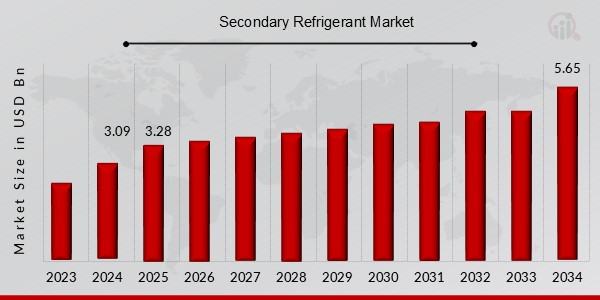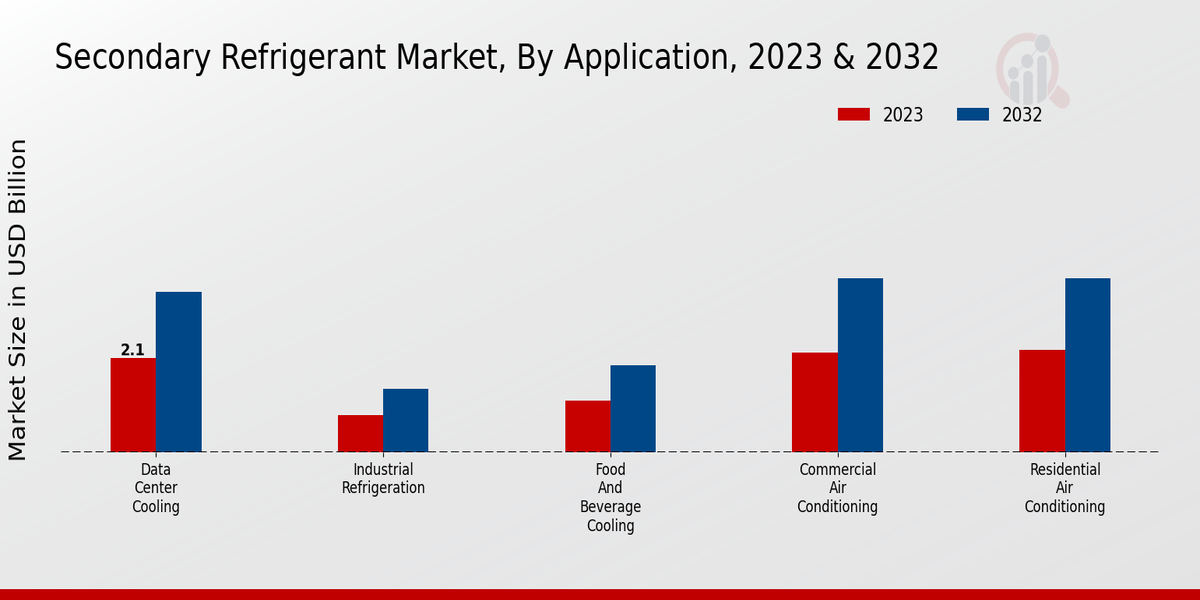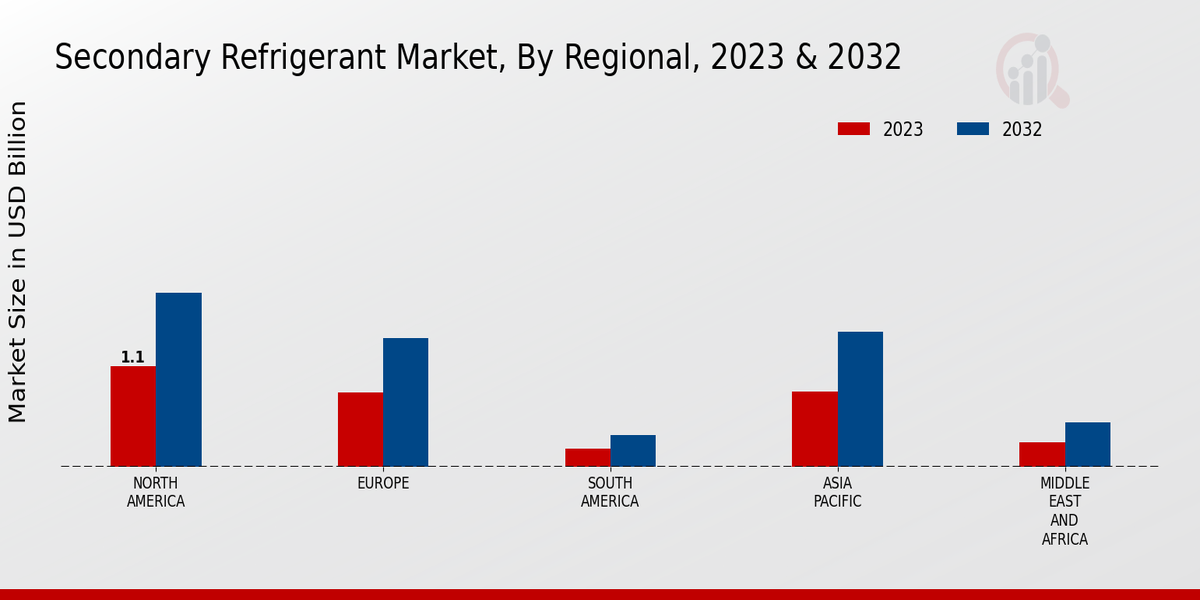Global Secondary Refrigerant Market Overview
Secondary Refrigerant Market Size was estimated at 3.09 (USD Billion) in 2024. The Secondary Refrigerant Industry is expected to grow from 3.28(USD Billion) in 2025 to 5.65(USD Billion) by 2034. The Secondary Refrigerant Market CAGR (growth rate) is expected to be around 6.20% during the forecast period (2025 - 2034).
Key Secondary Refrigerant Market Trends Highlighted
The Secondary Refrigerant Market is anticipated to witness robust growth driven by the increasing demand for energy-efficient cooling systems. Government regulations mandating reduced greenhouse gas emissions and the growing adoption of sustainable cooling technologies are key market drivers.
Emerging opportunities include the development of low global warming potential (GWP) refrigerants and advancements in smart control systems. The market is also witnessing a shift towards natural refrigerants, such as carbon dioxide and ammonia, which have lower environmental impact and higher cooling efficiency.
Recent trends in the Secondary Refrigerant Market include the adoption of distributed cooling systems to improve energy efficiency and reduce operating costs. Additionally, the increasing use of refrigerants with high latent heat of vaporization is gaining traction for applications requiring rapid cooling and temperature control.

Source: Primary Research, Secondary Research, Market Research Future Database and Analyst Review
Secondary Refrigerant Market Drivers
-
Increasing Demand for Energy-Efficient Cooling Systems
The rising global demand for energy-efficient cooling systems is a major driver of the secondary refrigerant market. Secondary refrigerants offer superior energy efficiency compared to traditional refrigerants, such as chlorofluorocarbons (CFCs) and hydrochlorofluorocarbons (HCFCs), which are being phased out due to their environmental impact. Secondary refrigerants have lower global warming potential (GWP) and ozone depletion potential (ODP), making them more environmentally friendly.Additionally, secondary refrigerants can operate at lower temperatures, reducing energy consumption and operating costs.
The growing adoption of energy-efficient cooling systems in various industries, including data centers, healthcare facilities, and food and beverage processing, is expected to continue to drive demand for secondary refrigerants in the coming years.
Growing Adoption of District Cooling Systems
The increasing adoption of district cooling systems is another key driver of the secondary refrigerant market. District cooling systems provide centralized cooling to multiple buildings or facilities, offering benefits such as reduced energy consumption, lower operating costs, and improved environmental performance. Secondary refrigerants play a crucial role in district cooling systems, as they allow for efficient distribution of chilled water over long distances with minimal energy loss.The growing demand for district cooling systems, particularly in densely populated urban areas, is expected to boost the demand for secondary refrigerants in the coming years.
Stringent Environmental Regulations
Stringent environmental regulations aimed at reducing greenhouse gas emissions and protecting the ozone layer are also driving the growth of the secondary refrigerant market. Governments around the world are implementing regulations to phase out the use of ozone-depleting substances and high-GWP refrigerants. Secondary refrigerants offer a viable alternative to traditional refrigerants, as they have lower environmental impact and comply with regulatory requirements.The increasing adoption of secondary refrigerants to meet environmental standards is expected to support market growth in the coming years.
Secondary Refrigerant Market Segment Insights
Secondary Refrigerant Market Application Insights
The Secondary Refrigerant Market segmentation by Application comprises Residential Air Conditioning, Commercial Air Conditioning, Industrial Refrigeration, Food and Beverage Cooling, and Data Center Cooling. In 2023, the Residential Air Conditioning segment held the largest revenue share, followed by Commercial Air Conditioning. The Industrial Refrigeration segment is expected to grow at the highest CAGR during the forecast period.
The growth of the Residential Air Conditioning segment is primarily driven by the increasing demand for energy-efficient and environmentally friendly cooling solutions in residential buildings.The Commercial Air Conditioning segment is also expected to witness significant growth due to the rising demand for air conditioning systems in commercial spaces such as offices, retail stores, and hospitals. The Industrial Refrigeration segment is projected to grow at a steady pace due to the increasing use of secondary refrigerants in industrial processes such as food processing, chemical manufacturing, and pharmaceuticals.
The Food and Beverage Cooling segment is also expected to grow at a healthy rate due to the rising demand for secondary refrigerants in food and beverage preservation and storage.The Data Center Cooling segment is anticipated to emerge as a lucrative market due to the growing number of data centers worldwide. Secondary refrigerants play a crucial role in cooling data centers, as they provide an efficient and environmentally friendly way to remove heat from servers and other equipment.
Overall, the Secondary Refrigerant Market is poised for robust growth in the coming years, driven by factors such as increasing demand for energy-efficient cooling solutions, rising environmental concerns, and growing adoption of secondary refrigerants in various applications.

Source: Primary Research, Secondary Research, Market Research Future Database and Analyst Review
Secondary Refrigerant Market Fluid Type Insights
The Fluid Type segment of the Secondary Refrigerant Market is anticipated to witness substantial growth in the coming years, driven by increasing demand for environmentally friendly and energy-efficient refrigerants. Hydrofluorocarbons (HFCs), which were widely used in the past, are being phased out due to their high global warming potential (GWP). As a result, there is a growing shift towards Hydrofluoroolefins (HFOs) and Natural Refrigerants (e.g., Ammonia, CO2), which have lower GWPs and offer better energy efficiency.
Secondary Refrigerant Market System Type Insights
The Secondary Refrigerant Market is segmented based on System Type into Direct Expansion (DX) Systems, Secondary Loop Systems, and Cascade Systems. Among these, the Secondary Loop Systems segment held the largest market share in 2023 and is projected to maintain its dominance throughout the forecast period. The growth of this segment can be attributed to the increasing adoption of secondary loop systems in supermarkets, restaurants, and other commercial applications due to their ability to provide precise temperature control and energy efficiency.
Direct Expansion (DX) Systems are expected to witness a moderate growth rate during the forecast period, owing to their simplicity and cost-effectiveness. Cascade Systems, on the other hand, are expected to experience a steady growth rate due to their high efficiency and ability to handle low-temperature applications. The Secondary Refrigerant Market segmentation provides a detailed overview of the market dynamics and helps industry participants identify potential growth opportunities.
Secondary Refrigerant Market Capacity Range Insights
The Secondary Refrigerant Market segmentation by Capacity Range comprises 'Less than 5 tons', '5-50 tons', '50-200 tons', and '200 tons and above'. The 'Less than 5 tons' segment accounted for a significant share of the market revenue in 2023, owing to its extensive application in small-scale refrigeration systems such as those used in residential and commercial buildings.
The '5-50 tons' segment is projected to register a steady growth rate over the forecast period, driven by its rising adoption in medium-sized commercial and industrial refrigeration applications.The '50-200 tons' segment is anticipated to witness notable growth, attributed to its increasing usage in large-scale industrial refrigeration systems. The '200 tons and above' segment is expected to gain significant traction in the coming years, driven by its application in large-scale industrial refrigeration systems and data centers.
Secondary Refrigerant Market End-Use Sector Insights
The Secondary Refrigerant Market segmentation by End-Use Sector encompasses various industries that utilize secondary refrigerants for cooling applications. In 2023, the residential sector held a significant market share, driven by the growing demand for air conditioning and refrigeration systems in homes. The commercial sector is projected to witness steady growth due to the increasing construction of commercial buildings and the need for efficient cooling solutions.
The industrial sector is expected to contribute a substantial share, owing to the rising demand for secondary refrigerants in manufacturing processes and data centers.The healthcare sector is also poised for growth, fueled by the expansion of healthcare facilities and the need for reliable cooling systems for medical equipment. The transportation sector is witnessing increasing adoption of secondary refrigerants in refrigerated transport and cold storage applications. Overall, the Secondary Refrigerant Market is projected to reach a valuation of USD 4.06 billion by 2029, exhibiting a CAGR of 5.8% during the forecast period.
Secondary Refrigerant Market Regional Insights
The regional segmentation of the Secondary Refrigerant Market offers crucial insights into the market dynamics across different regions. North America is anticipated to hold a dominant share of the market due to the presence of well-established industries and stringent environmental regulations. Europe is expected to follow closely, driven by increasing demand for energy-efficient cooling solutions. APAC is projected to exhibit significant growth potential due to rapid urbanization and rising disposable income. South America and MEA are anticipated to contribute a smaller share of the global market, but they are expected to witness steady growth in the coming years.

Source: Primary Research, Secondary Research, Market Research Future Database and Analyst Review
Secondary Refrigerant Market Key Players And Competitive Insights
Major players in the Secondary Refrigerant Market industry are constantly striving to gain a competitive edge by developing innovative products and expanding their global reach. Leading Secondary Refrigerant Market players are focusing on strategic collaborations, acquisitions, and partnerships to strengthen their market position and capitalize on growth opportunities. The Secondary Refrigerant Market development is driven by increasing demand from various end-use industries, such as food and beverage, pharmaceuticals, and data centers. Emerging trends in the Secondary Refrigerant Market include the growing adoption of eco-friendly refrigerants and the integration of advanced technologies to improve efficiency and reduce environmental impact.
The Secondary Refrigerant Market Competitive Landscape is expected to remain dynamic in the coming years, with established players and new entrants vying for market share.A leading company in the Secondary Refrigerant Market, Linde has established a strong global presence with operations in over 100 countries. The company offers a wide range of secondary refrigerants, including propylene glycol, ethylene glycol, and ammonia, to cater to diverse industry needs. Linde's focus on innovation has led to the development of advanced secondary refrigerant systems that optimize performance and minimize environmental impact.
The company's commitment to sustainability has earned it recognition and partnerships with organizations promoting environmental stewardship.A notable competitor in the Secondary Refrigerant Market, Dow, is known for its extensive portfolio of secondary refrigerants. The company's products include high-purity glycols, which are used in various applications, such as food processing, pharmaceuticals, and data centers. Dow's emphasis on research and development has resulted in the introduction of innovative secondary refrigerant solutions that meet the evolving demands of the market. The company's global reach and established distribution network enable it to serve customers worldwide.
Dow's commitment to customer satisfaction and technical support has contributed to its strong reputation in the Secondary Refrigerant Market.
Key Companies in the Secondary Refrigerant Market Include:
Secondary Refrigerant Market Industry Developments
Rising demand for energy-efficient cooling solutions in various industries, coupled with increasing environmental concerns, is driving market growth. The adoption of secondary refrigerants, such as glycol-based fluids and brine solutions, is gaining traction due to their ability to reduce energy consumption and carbon emissions compared to traditional refrigerants. Technological advancements, such as the development of low-temperature secondary refrigerants, are further expanding market opportunities. Key players in the market include LyondellBasell, Dow, BASF, and Eastman Chemical Company.
Recent developments include the launch of new secondary refrigerant products with enhanced performance and sustainability features, as well as strategic partnerships and acquisitions to strengthen market presence.
Secondary Refrigerant Market Segmentation Insights
-
Secondary Refrigerant Market Application Outlook
-
Secondary Refrigerant Market Fluid Type Outlook
-
Secondary Refrigerant Market System Type Outlook
-
Secondary Refrigerant Market Capacity Range Outlook
-
Secondary Refrigerant Market End-Use Sector Outlook
-
Secondary Refrigerant Market Regional Outlook
| Report Attribute/Metric |
Details |
| Market Size 2024 |
3.09(USD Billion) |
| Market Size 2025 |
3.28(USD Billion) |
| Market Size 2034 |
5.65(USD Billion) |
| Compound Annual Growth Rate (CAGR) |
6.20% (2025 - 2034) |
| Report Coverage |
Revenue Forecast, Competitive Landscape, Growth Factors, and Trends |
| Base Year |
2024 |
| Market Forecast Period |
2025 - 2034 |
| Historical Data |
2020 - 2024 |
| Market Forecast Units |
USD Billion |
| Key Companies Profiled |
Trane Technologies, Zhongke Refrigerant, Zhejiang Guohong, JXTG Nippon Oil Energy, Linde, Kouraku, Weihai Haoyu, Zhongke Yuchang, Chemours, Praxair, Messer Group, Daikin Industries, Refrigerant Technologies, Honeywell International |
| Segments Covered |
Application, Fluid Type, System Type, Capacity Range, End-Use Sector, Regional |
| Key Market Opportunities |
Growing demand for energy efficiency Increasing adoption in the food and beverage industry Expansion of cold chain infrastructure Rising concerns about ozone depletion Technological advancements in secondary refrigerants |
| Key Market Dynamics |
Demand Surge in HVAC Systems Growing Emphasis on Energy Efficiency Expansion of Cold Chain Infrastructure Technological Advancements in Refrigeration Increasing Adoption of Natural Refrigerants |
| Countries Covered |
North America, Europe, APAC, South America, MEA |
Frequently Asked Questions (FAQ):
The Secondary Refrigerant Market is expected to be worth 3.28 billion USD in 2025.
The market is projected to grow at a CAGR of 6.20% from 2025 to 2034.
The market is expected to reach 5.65 billion USD by 2034.
Secondary refrigerants are primarily used in industrial refrigeration systems, data centers, and food processing.
Key competitors include companies such as Honeywell, Chemours, and Daikin.
Growing demand for energy-efficient cooling solutions and increasing adoption of secondary refrigerants in various industries are driving the market growth.
Environmental regulations and the availability of low-GWP refrigerants pose challenges to the market.
Technological advancements and increasing demand for sustainable cooling solutions present opportunities for market growth.
Focus on sustainability, adoption of natural refrigerants, and advancements in refrigeration technologies are key trends shaping the market.
















